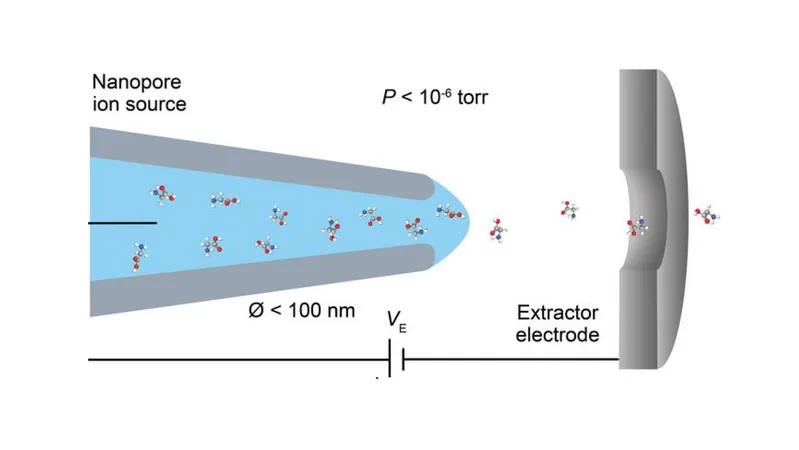
Revolutionary Breakthrough in Mass Spectrometry: Groundbreaking Nanopore Ion Technology Could Unlock New Levels in Sample Analysis!
2024-11-22
Author: Yu
Introduction to Mass Spectrometry
Mass spectrometry has long been hailed as a crucial tool for scientists striving to understand the composition of materials at the molecular level. This powerful technique identifies and quantifies the diverse building blocks of substances by measuring the mass of tiny particles. However, until now, a major hindrance has plagued the accuracy and effectiveness of mass spectrometry – a staggering 99% of the sample typically gets lost during the measurement process. But a new era is on the horizon!
Innovative Approach from Brown University
Researchers at Brown University have unveiled an innovative approach to overcoming this challenge, significantly reducing sample loss and enhancing the precision of mass spectrometry. Their cutting-edge method hinges on a remarkable advancement known as the nanopore ion source, which could radically transform the landscape of sample analysis.
The Limitation of Traditional Methodologies
Nicholas Drachman, a Ph.D. candidate in physics and lead author of the study, explains the limitation of traditional methodologies: “Conventional electrospray ionization generates a spray of droplets from a sharp needle placed in front of the mass spectrometer. This results in only a tiny fraction reaching the device, leading to substantial material waste and compromised precision.”
The Breakthrough of Nanopore Ion Source
The breakthrough from the Brown University team features a minuscule capillary measuring approximately 30 nanometers wide—about 1,000 times narrower than a human hair! In contrast, traditional devices use openings that are around 20 micrometers in diameter, wasting vast amounts of precious samples.
Direct Transfer of Ions
What sets the nanopore ion source apart is its ability to directly transfer ions dissolved in water into the vacuum of the mass spectrometer without the need for generating a spray that must then be dried. This eliminates the significant gas intake associated with conventional methods, simplifying the hardware requirements of mass spectrometers and reducing operational costs.
Streamlined Process
Drachman elaborates, “By generating ions directly in the vacuum, we streamline the process, reducing the burden on vacuum pumps and complex machinery.” This innovation paves the way for more accessible and efficient mass spectrometry equipment, essentially creating a more user-friendly setup for researchers.
Revolutionizing Protein Analysis
Inspired by breakthroughs in nanopore sequencing technology for DNA, the Brown team aims to revolutionize protein analysis—a field that has lagged behind genomic advancements. Derek Stein, a professor of physics at Brown, articulates the hope resting on this research: “Mass spectrometry shines in protein analysis, as it can distinguish complex amino acid structures with unparalleled accuracy.” The ultimate goal? To enable researchers to sequence proteins one amino acid at a time, unlocking a treasure trove of data that could lead to groundbreaking discoveries in multiple fields, ranging from drug development to disease diagnostics.
Proof of Concept
The data shared in the team's recent publication serves as proof of their concept, confirming that their method achieves comparable ion detection results to conventional techniques, but with dramatically less sample loss. Looking ahead, they aim to further refine this innovation and illustrate its potential for reshaping workflows in proteomics.
Future Implications
With a decade of dedicated research behind them, the Brown University's team is eager to deliver enhancements that could significantly benefit scientists worldwide seeking to delve deeper into the complex world of proteins. The journey to resolve sample loss issues is just beginning, and the implications of this technology could reverberate across scientific communities for years to come. Keep an eye on this developing story—it may very well lead to breakthroughs that reshape our understanding of biology and beyond!




 Brasil (PT)
Brasil (PT)
 Canada (EN)
Canada (EN)
 Chile (ES)
Chile (ES)
 España (ES)
España (ES)
 France (FR)
France (FR)
 Hong Kong (EN)
Hong Kong (EN)
 Italia (IT)
Italia (IT)
 日本 (JA)
日本 (JA)
 Magyarország (HU)
Magyarország (HU)
 Norge (NO)
Norge (NO)
 Polska (PL)
Polska (PL)
 Schweiz (DE)
Schweiz (DE)
 Singapore (EN)
Singapore (EN)
 Sverige (SV)
Sverige (SV)
 Suomi (FI)
Suomi (FI)
 Türkiye (TR)
Türkiye (TR)